
Chandragupta II, also known by his title Vikramaditya, as well as Chandragupta Vikramaditya, was the third ruler of the Gupta Empire in India, and was one of the most powerful emperors of the Gupta dynasty.
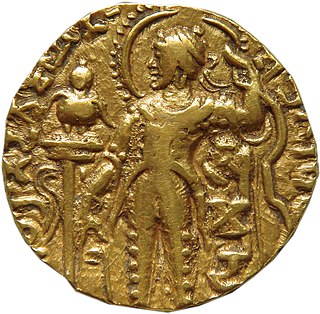
Samudragupta (Gupta script: Sa-mu-dra-gu-pta, was the second emperor of the Gupta Empire of ancient India, and is regarded among the greatest rulers of the dynasty. As a son of the Gupta emperor Chandragupta I and the Licchavi princess Kumaradevi, he greatly expanded his dynasty's political and military power.

The Satavahanas, also referred to as the Andhras in the Puranas, were an ancient Indian dynasty based in the Deccan region. Most modern scholars believe that the Satavahana rule began in the late second century BCE and lasted until the early third century CE, although some assign the beginning of their rule to as early as the 3rd century BCE based on the Puranas, but uncorroborated by archaeological evidence. The Satavahana kingdom mainly comprised the present-day Andhra Pradesh, Telangana, and Maharashtra. At different times, their rule extended to parts of modern Gujarat, Madhya Pradesh, and Karnataka. The dynasty had different capital cities at different times, including Pratishthana (Paithan) and Amaravati (Dharanikota).

Skandagupta was a Gupta Emperor of India. His Bhitari pillar inscription suggests that he restored the Gupta power by defeating his enemies, who may have been rebels or foreign invaders. He repulsed an invasion by the Indo-Hephthalites, probably the Kidarites. He seems to have maintained control of his inherited territory, and is generally considered the last of the great Gupta Emperors. The Gupta genealogy after him is unclear, but he was most probably succeeded by Purugupta, who appears to have been his younger half-brother.
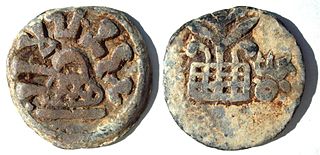
The Chutu dynasty ruled parts of the Deccan region of South India between first and third centuries CE, with its capital at Banavasi in present-day Karnataka state. The Chutus probably rose to power as Satavahanas feudatories, and assumed sovereignty after the decline of the Satavahana power. Except for the edicts of Asoka, the inscriptions of the Chutu dynasty are the oldest documents found in the northern part of Karnataka State, India.

The Shaka era is a historical Hindu calendar era, the epoch of which corresponds to Julian year 78.
The Western Satraps, or Western Kshatrapas were Indo-Scythian (Saka) rulers of the western and central part of India, between 35 to 415 CE. The Western Satraps were contemporaneous with the Kushans who ruled the northern part of the Indian subcontinent, and were possibly vassals of the Kushans. They were also contemporaneous with the Satavahana (Andhra) who ruled in Central India. They are called "Western Satraps" in modern historiography in order to differentiate them from the "Northern Satraps", who ruled in Punjab and Mathura until the 2nd century CE.
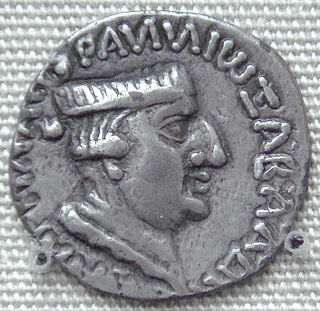
Nahapana, was an important ruler of the Western Kshatrapas, descendant of the Indo-Scythians, in northwestern India, who ruled during the 1st or 2nd century CE. According to one of his coins, he was the son of Bhumaka.
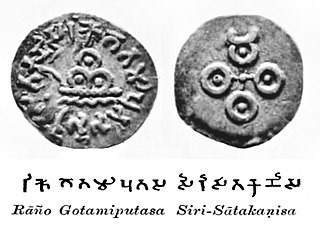
Gautamiputra Satakarni was a ruler of the Satavahana Empire in present-day Deccan region of India. He was mentioned as the important and greatest ruler of Satavahana Dynasty. He ruled in the 1st or 2nd century CE, although his exact period is uncertain. His reign is dated variously: 86-110 CE, c. 103-127 CE, 106-130 CE, or more recently and specifically ca. 60-85 CE.

Rudradāman I was a Śaka ruler from the Western Kshatrapas dynasty. He was the grandson of the king Caṣṭana. Rudradāman I was instrumental in the decline of the Sātavāhana Empire. Rudradāman I took up the title of Maha-kshtrapa, after he became the king and then strengthened his kingdom.

The Ikshvaku dynasty ruled in the eastern Krishna River valley of India, from their capital at Vijayapuri during approximately 3rd and 4th centuries CE. The Ikshvakus are also known as the Andhra Ikshvakus or Ikshvakus of Vijayapuri to distinguish them from their legendary namesakes.

Rudrasena I was a Saka ruler of the Western Satrap dynasty in the area of Malwa in ancient India. During his reign, the Saka ksatrapas remained strong after a period of instability during the reign of Rudrasimha I.

Ushavadata, also known as Rishabhadatta, was a viceroy and son-in-law of the Western Kshatrapa ruler Nahapana, who ruled in western India.
The Malavas or Malwas were an ancient Indian tribe. Modern scholars identify them with the Mallian people (Malloi) who were settled in the Punjab region at the time of Alexander's invasion in the 4th century BCE. Later, the Malavas migrated southwards to present-day Rajasthan, and ultimately to Madhya Pradesh and Gujarat. Their power gradually declined as a result of defeats against the Western Satraps, the Gupta emperor Samudragupta, and the Chalukya emperor Pulakeshin II.

The legacy of the Indo-Greeks starts with the formal end of the Indo-Greek Kingdom from the 1st century, as the Greek communities of central Asia and northwestern India lived under the control of the Kushan branch of the Yuezhi, apart from a short-lived invasion of the Indo-Parthian Kingdom. The Kushans founded the Kushan Empire, which was to prosper for several centuries. In the south, the Greeks were under the rule of the Western Kshatrapas.

Jivadaman was a Saka ruler of the Western Kshatrapas in northwestern India from during the 2nd century CE. He was the son of Damajadasri I (170–175), and the brother of Satyadaman.

Ishwarsena Abhira also known by his alias Mahaksatrapa Isvardatta was the founder of the Abhira dynasty. He and his descendants, whose names occur in the Puranas, seem to have ruled over a large territory in the Deccan. He took the title of Rajan and an era was named after him. His descendants ruled for nine generations.

The Nashik inscription of Ushavadata is an inscription made in the Nashik Caves by Ushavadata, a son-in-law of the Western Satraps ruler Nahapana, in the years circa 120 CE. It is the earliest known instance of the usage of Sanskrit, although a rather hybrid form, in western India. It also documents the Indian tradition of dana (charity) to Brahmins, Buddhists and of building infrastructure to serve pilgrims and the general public by the 2nd-century CE.

The Abhira dynasty was a dynasty that ruled over the western Deccan, where they succeeded the Satavahanas. From 203 to roughly 260, they formed a vast kingdom. They belonged to the ancient Abhira tribe. Abhira Era started by Ishwarsena in AD 249, continued with them and was called Abhira-Traikutika era. This era was later continued by Kalachuri Dynasty, calling it Kalachuri era, and later Kalachuri-Chedi era. After the rule of five traikuta kings, they retired to central provinces and assumed the name Haihaya and Kalachuri. Historians call this entire era as Abhira-Traikutika-Kalachuri-Chedi era.
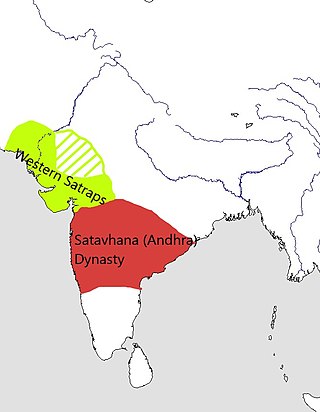
The Saka-Satavahana Wars were a series of conflicts fought between the Saka ksatraps and the Satavahanas during the 1st-2nd century CE. Both sides achieved success at varying points during the conflicts, but in the end, it was the Satvahanas which prevailed. However, constant wars with the Sakas severely weakened them and was a major contributor in their fall.






















